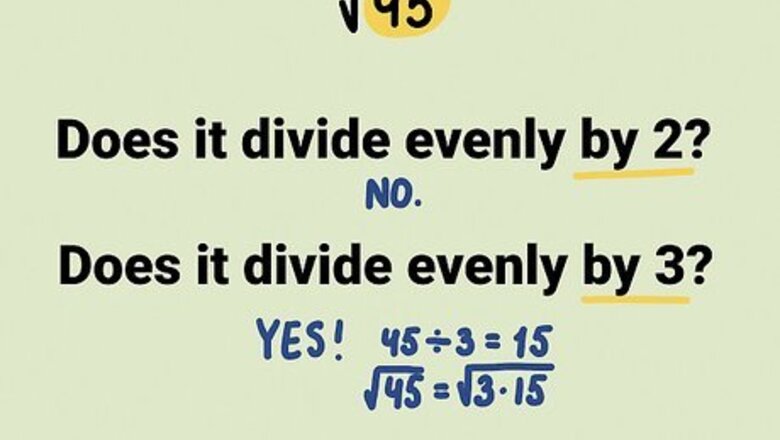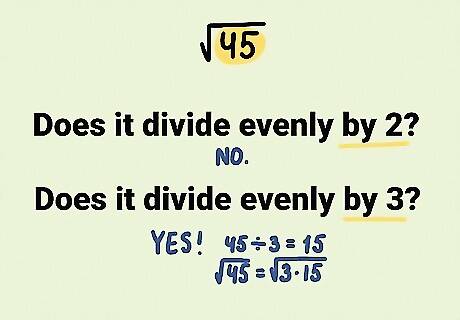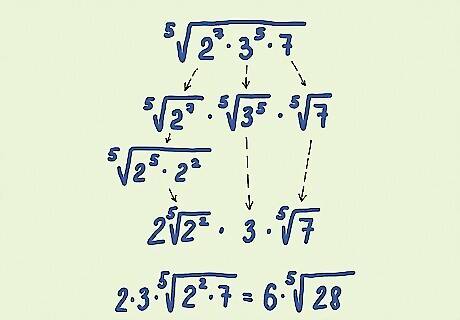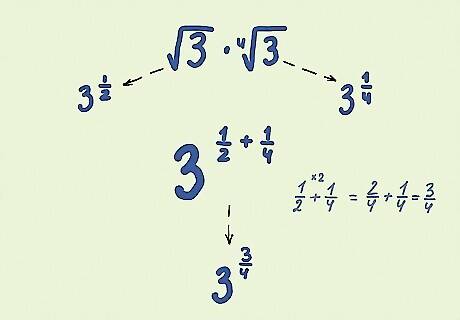
views
6
2
{\displaystyle 6^{2}}
is "six squared", and
6
{\displaystyle {\sqrt {6}}}
is "the square root of six". And just like we can use larger and larger exponents like
3
{\displaystyle ^{3}}
and
4
{\displaystyle ^{4}}
, we can also find smaller and smaller roots like
3
{\displaystyle {\sqrt[{3}]{}}}
and
4
{\displaystyle {\sqrt[{4}]{}}}
. Simplifying radical expressions uses many of the same tricks you've learned in earlier math lessons for simplifying fractions or exponents. If you're new to the topic, start by learning how to simplify the square root of an integer.
Simplifying the Square Root of an Integer

Factor the number under the square root. Ignore the square root for now and just look at the number underneath it. Factor that number by writing it as the product of two smaller numbers. (If the factors aren't obvious, just see if it divides evenly by 2. If not, try again with 3, then 4, and so on, until you find a factor that works.) Example: Simplify 45 {\displaystyle {\sqrt {45}}} {\displaystyle {\sqrt {45}}}. The first step is finding some factors of 45. You can't divide 45 by 2, so try dividing it by 3 instead: 45 ÷ 3 = 15 {\displaystyle 45\div 3=15} {\displaystyle 45\div 3=15}, so 45 = 3 × 15 {\displaystyle 45=3\times 15} {\displaystyle 45=3\times 15}. 45 = 3 × 15 {\displaystyle {\sqrt {45}}={\sqrt {3\times 15}}} {\displaystyle {\sqrt {45}}={\sqrt {3\times 15}}}
Keep going until the number is factored completely. Remember, any number can be factored down into prime numbers (like 2, 3, 5, and 7). Keep breaking down the factors until there are no more factors to find. Now we have 3 × 15 {\displaystyle {\sqrt {3\times 15}}} {\displaystyle {\sqrt {3\times 15}}}, but we can factor 15 again into 3 × 5 {\displaystyle 3\times 5} {\displaystyle 3\times 5}. 45 = 3 × 3 × 5 {\displaystyle {\sqrt {45}}={\sqrt {3\times 3\times 5}}} {\displaystyle {\sqrt {45}}={\sqrt {3\times 3\times 5}}}
Rewrite pairs of the same number as powers of 2. If the same factor shows up more than once, rewrite it as an exponent. (Keep everything underneath the square root.) In 3 × 3 × 5 {\displaystyle {\sqrt {3\times 3\times 5}}} {\displaystyle {\sqrt {3\times 3\times 5}}}, the number 3 shows up twice. Since 3 × 3 = 3 2 {\displaystyle 3\times 3=3^{2}} {\displaystyle 3\times 3=3^{2}}, we can rewrite the whole expression as 3 2 × 5 {\displaystyle {\sqrt {3^{2}\times 5}}} {\displaystyle {\sqrt {3^{2}\times 5}}}.
Take any numbers raised to the power of 2 outside the square root. Roots and exponents are opposite, so they cancel each other out. If any factors are raised to the power of 2, move that factor in front of the square root (and get rid of the exponent). 3 2 × 5 = 3 2 5 {\displaystyle {\sqrt {3^{2}\times 5}}={\sqrt {3^{2}}}{\sqrt {5}}} {\displaystyle {\sqrt {3^{2}\times 5}}={\sqrt {3^{2}}}{\sqrt {5}}} (As long as everything underneath the root is one multiplication problem, you can always rewrite the expression like this, with a root over each product.) 3 2 5 = 3 5 {\displaystyle {\sqrt {3^{2}}}{\sqrt {5}}=3{\sqrt {5}}} {\displaystyle {\sqrt {3^{2}}}{\sqrt {5}}=3{\sqrt {5}}} Since there are no other exponents left under the square root, you're all done!
Simplify the result so there is no multiplication left. In more difficult problems, you might end up with multiple numbers in front of the square root, or underneath it. Solve these multiplication problems to simplify the answer. Example: Simplify 360 {\displaystyle {\sqrt {360}}} {\displaystyle {\sqrt {360}}}. This takes a lot of factoring to break down: 360 = 40 × 9 = ( 5 × 8 ) × ( 3 × 3 ) = 5 × 2 × 2 × 2 × 3 × 3 {\displaystyle {\sqrt {360}}={\sqrt {40\times 9}}={\sqrt {(5\times 8)\times (3\times 3)}}={\sqrt {5\times 2\times 2\times 2\times 3\times 3}}} {\displaystyle {\sqrt {360}}={\sqrt {40\times 9}}={\sqrt {(5\times 8)\times (3\times 3)}}={\sqrt {5\times 2\times 2\times 2\times 3\times 3}}} Rewrite pairs of numbers using exponents: 5 × 2 2 × 2 × 3 2 {\displaystyle {\sqrt {5\times 2^{2}\times 2\times 3^{2}}}} {\displaystyle {\sqrt {5\times 2^{2}\times 2\times 3^{2}}}}. Bring the 2 and 3 outside the square root: 2 × 3 × 5 × 2 {\displaystyle 2\times 3\times {\sqrt {5\times 2}}} {\displaystyle 2\times 3\times {\sqrt {5\times 2}}} Simplify the numbers in front of the square root: 6 5 × 2 {\displaystyle 6{\sqrt {5\times 2}}} {\displaystyle 6{\sqrt {5\times 2}}} To get the final answer, simplify the numbers under the square root: 6 10 {\displaystyle 6{\sqrt {10}}} {\displaystyle 6{\sqrt {10}}}
Simplifying Cube Roots and Higher Roots
Find the prime factors of the number under the root. Just like square roots, the first step to simplifying a cube root ( 3 {\displaystyle {\sqrt[{3}]{}}} {\displaystyle {\sqrt[{3}]{}}}), a fourth root ( 4 {\displaystyle {\sqrt[{4}]{}}} {\displaystyle {\sqrt[{4}]{}}}), or any higher root is to factor the number under the root. Example: Simplify 81 3 {\displaystyle {\sqrt[{3}]{81}}} {\displaystyle {\sqrt[{3}]{81}}} (the cube root of 81). 81 = 3 × 3 × 3 × 3 {\displaystyle 81=3\times 3\times 3\times 3} {\displaystyle 81=3\times 3\times 3\times 3}, so 81 3 = 3 × 3 × 3 × 3 3 {\displaystyle {\sqrt[{3}]{81}}={\sqrt[{3}]{3\times 3\times 3\times 3}}} {\displaystyle {\sqrt[{3}]{81}}={\sqrt[{3}]{3\times 3\times 3\times 3}}}
Rewrite groups of the same factors in exponent form. If the same prime factor shows up more than once, rewrite them as an exponent. 3 × 3 × 3 × 3 3 = 3 4 3 {\displaystyle {\sqrt[{3}]{3\times 3\times 3\times 3}}={\sqrt[{3}]{3^{4}}}} {\displaystyle {\sqrt[{3}]{3\times 3\times 3\times 3}}={\sqrt[{3}]{3^{4}}}}
Simplify the root of exponents wherever possible. Just as a square root cancels out a square, higher roots cancel out matching exponents (for instance, 3 {\displaystyle {\sqrt[{3}]{}}} {\displaystyle {\sqrt[{3}]{}}} and 3 {\displaystyle ^{3}} {\displaystyle ^{3}}). Check out this example to see how this works: 3 4 3 = 3 3 × 3 3 = 3 3 3 3 3 {\displaystyle {\sqrt[{3}]{3^{4}}}={\sqrt[{3}]{3^{3}\times 3}}={\sqrt[{3}]{3^{3}}}{\sqrt[{3}]{3}}} {\displaystyle {\sqrt[{3}]{3^{4}}}={\sqrt[{3}]{3^{3}\times 3}}={\sqrt[{3}]{3^{3}}}{\sqrt[{3}]{3}}} Since the root and exponent match in 3 3 3 {\displaystyle {\sqrt[{3}]{3^{3}}}} {\displaystyle {\sqrt[{3}]{3^{3}}}}, they cancel out, leaving only the base number, 3 {\displaystyle 3} 3. Plug that into the whole expression to get 3 3 3 {\displaystyle 3{\sqrt[{3}]{3}}} {\displaystyle 3{\sqrt[{3}]{3}}}. Since there are no more exponents left that can cancel out, this is the simplified form.

Simplify any multiplication and exponents. You'll often end up with exponents that don't cancel out, or with more than one number multiplied together. Solve for these so you end up with one number outside the radical, and one number inside it. Example: Simplify 2 7 × 3 5 × 7 5 {\displaystyle {\sqrt[{5}]{2^{7}\times 3^{5}\times 7}}} {\displaystyle {\sqrt[{5}]{2^{7}\times 3^{5}\times 7}}}. This is already factored into prime numbers, so we can skip that step. Let's rewrite this as 2 7 5 3 5 5 7 5 {\displaystyle {\sqrt[{5}]{2^{7}}}{\sqrt[{5}]{3^{5}}}{\sqrt[{5}]{7}}} {\displaystyle {\sqrt[{5}]{2^{7}}}{\sqrt[{5}]{3^{5}}}{\sqrt[{5}]{7}}}. 2 7 5 = 2 5 × 2 2 5 {\displaystyle {\sqrt[{5}]{2^{7}}}={\sqrt[{5}]{2^{5}\times 2^{2}}}} {\displaystyle {\sqrt[{5}]{2^{7}}}={\sqrt[{5}]{2^{5}\times 2^{2}}}}, by the rules of exponents. The root and exponent cancel out in the first term, leaving 2 2 2 5 {\displaystyle 2{\sqrt[{5}]{2^{2}}}} {\displaystyle 2{\sqrt[{5}]{2^{2}}}} In 3 5 5 {\displaystyle {\sqrt[{5}]{3^{5}}}} {\displaystyle {\sqrt[{5}]{3^{5}}}}, the root and exponent cancel out to make 3 {\displaystyle 3} 3. Since 7 5 {\displaystyle {\sqrt[{5}]{7}}} {\displaystyle {\sqrt[{5}]{7}}} has no exponents that cancel out, this can't be simplified. Plug your simplified terms back into the whole expression: 2 2 2 5 × 3 × 7 5 {\displaystyle 2{\sqrt[{5}]{2^{2}}}\times 3\times {\sqrt[{5}]{7}}} {\displaystyle 2{\sqrt[{5}]{2^{2}}}\times 3\times {\sqrt[{5}]{7}}} Combine like terms: ( 2 × 3 ) 2 2 × 7 5 {\displaystyle (2\times 3){\sqrt[{5}]{2^{2}\times 7}}} {\displaystyle (2\times 3){\sqrt[{5}]{2^{2}\times 7}}} Calculate multiplication and exponents: 6 28 5 {\displaystyle 6{\sqrt[{5}]{28}}} {\displaystyle 6{\sqrt[{5}]{28}}}
Simplifying Fractions inside Roots
Simplify the fraction. What if a whole fraction is underneath a root? One way to solve problems like this is to ignore the radical expression at first. Simplify the fraction as much as you can, then see if the root lets you simplify further. Example: Simplify 100 4 {\displaystyle {\sqrt {\frac {100}{4}}}} {\displaystyle {\sqrt {\frac {100}{4}}}}. 100 4 = 25 {\displaystyle {\frac {100}{4}}=25} {\displaystyle {\frac {100}{4}}=25}, so we can rewrite this as 25 {\displaystyle {\sqrt {25}}} {\displaystyle {\sqrt {25}}}. 25 = 5 2 {\displaystyle 25=5^{2}} {\displaystyle 25=5^{2}}, so 25 = 5 {\displaystyle {\sqrt {25}}=5} {\displaystyle {\sqrt {25}}=5}.
Rewrite the fraction as two radical expressions instead. Some people prefer this other method of solving problems like this. Rewrite the fraction so there is one root in the numerator and another in the denominator. Simplify each root separately, then simplify the fraction. Example: Simplify 75 12 {\displaystyle {\sqrt {\frac {75}{12}}}} {\displaystyle {\sqrt {\frac {75}{12}}}}. Rewrite this as 75 12 {\displaystyle {\frac {\sqrt {75}}{\sqrt {12}}}} {\displaystyle {\frac {\sqrt {75}}{\sqrt {12}}}}. Simplify the numerator: 75 = 25 × 3 = 5 3 {\displaystyle {\sqrt {75}}={\sqrt {25\times 3}}=5{\sqrt {3}}} {\displaystyle {\sqrt {75}}={\sqrt {25\times 3}}=5{\sqrt {3}}} Simplify the denominator: 12 = 4 × 3 = 2 3 {\displaystyle {\sqrt {12}}={\sqrt {4\times 3}}=2{\sqrt {3}}} {\displaystyle {\sqrt {12}}={\sqrt {4\times 3}}=2{\sqrt {3}}} Plug these back into the fraction: 5 3 2 3 {\displaystyle {\frac {5{\sqrt {3}}}{2{\sqrt {3}}}}} {\displaystyle {\frac {5{\sqrt {3}}}{2{\sqrt {3}}}}} Cancel out 3 {\displaystyle {\sqrt {3}}} {\sqrt {3}} to get 5 2 {\displaystyle {\frac {5}{2}}} {\frac {5}{2}}.
Adjust your answer so there are no roots in the denominator. Sometimes, the simplest form still has a radical expression. That's fine, but most math teachers want you to keep any radicals in the top of the fraction, not the denominator. Follow the rules for multiplying fractions to cancel out any roots on the bottom of your fraction: Example: You've simplified a fraction and got the answer 4 9 5 {\displaystyle {\frac {4}{9{\sqrt {5}}}}} {\displaystyle {\frac {4}{9{\sqrt {5}}}}}. To put it in standard form, multiply the top and bottom of the fraction by the root: 4 × 5 9 5 × 5 = 4 5 9 × 5 = 4 5 45 {\displaystyle {\frac {4\times {\sqrt {5}}}{9{\sqrt {5}}\times {\sqrt {5}}}}={\frac {4{\sqrt {5}}}{9\times 5}}={\frac {4{\sqrt {5}}}{45}}} {\displaystyle {\frac {4\times {\sqrt {5}}}{9{\sqrt {5}}\times {\sqrt {5}}}}={\frac {4{\sqrt {5}}}{9\times 5}}={\frac {4{\sqrt {5}}}{45}}}
Combining Roots of Different Kinds
Convert roots to fractional exponents. You can rewrite any root as an exponent with a fractional value. The pattern is pretty straightforward once you're used to it: x = x 1 2 {\displaystyle {\sqrt {x}}=x^{\frac {1}{2}}} {\sqrt {x}}=x^{{{\frac {1}{2}}}} x 3 = x 1 3 {\displaystyle {\sqrt[{3}]{x}}=x^{\frac {1}{3}}} {\displaystyle {\sqrt[{3}]{x}}=x^{\frac {1}{3}}} x 4 = x 1 4 {\displaystyle {\sqrt[{4}]{x}}=x^{\frac {1}{4}}} {\displaystyle {\sqrt[{4}]{x}}=x^{\frac {1}{4}}} ...and so on.

Combine the terms using exponent rules. Once you've converted your terms to exponent form, follow the rules of exponents to combine them into a single expression. Example: Write 3 3 4 {\displaystyle {\sqrt {3}}{\sqrt[{4}]{3}}} {\displaystyle {\sqrt {3}}{\sqrt[{4}]{3}}} as one radical expression. Rewrite each term in exponent form: 3 {\displaystyle {\sqrt {3}}} {\sqrt {3}} becomes 3 1 2 {\displaystyle 3^{\frac {1}{2}}} {\displaystyle 3^{\frac {1}{2}}}, and 3 4 {\displaystyle {\sqrt[{4}]{3}}} {\displaystyle {\sqrt[{4}]{3}}} becomes 3 1 4 {\displaystyle 3^{\frac {1}{4}}} {\displaystyle 3^{\frac {1}{4}}}. The whole expression is now 3 1 2 × 3 1 4 {\displaystyle 3^{\frac {1}{2}}\times 3^{\frac {1}{4}}} {\displaystyle 3^{\frac {1}{2}}\times 3^{\frac {1}{4}}}. Since the exponents have the same base (3), multiplying them together gives us the same base raised to the sum of the two exponents: 3 ( 1 2 + 1 4 ) {\displaystyle 3^{({\frac {1}{2}}+{\frac {1}{4}})}} {\displaystyle 3^{({\frac {1}{2}}+{\frac {1}{4}})}}. Simplify to 3 3 4 {\displaystyle 3^{\frac {3}{4}}} {\displaystyle 3^{\frac {3}{4}}}.
Convert back to radical form. Once you have a single term with a fractional exponent, rewrite it as a radical expression. (The denominator moves to the root, and the numerator stays as an exponent.) 3 3 4 = 3 3 4 {\displaystyle 3^{\frac {3}{4}}={\sqrt[{4}]{3^{3}}}} {\displaystyle 3^{\frac {3}{4}}={\sqrt[{4}]{3^{3}}}}
Simplify if possible. If you have any multiplication or exponents left, calculate them so your final answer is in simplest form. 3 3 4 = 9 4 {\displaystyle {\sqrt[{4}]{3^{3}}}={\sqrt[{4}]{9}}} {\displaystyle {\sqrt[{4}]{3^{3}}}={\sqrt[{4}]{9}}}
Simplifying Radical Expressions with Variables
Cancel out exponents and roots just as you would with integers. Algebraic problems involve variables like x {\displaystyle x} x that can represent any number. The rules for exponents and roots still apply to these variables. Example: Simplify x 2 × x 3 {\displaystyle {\sqrt[{3}]{x^{2}\times x}}} {\displaystyle {\sqrt[{3}]{x^{2}\times x}}}. Combine the terms under the cube root just like you would a number: x 3 3 {\displaystyle {\sqrt[{3}]{x^{3}}}} {\displaystyle {\sqrt[{3}]{x^{3}}}} Since the root and the exponent values match, they cancel out to make x {\displaystyle x} x.
Give positive solutions to even roots. Notice how ( − 2 ) 2 {\displaystyle (-2)^{2}} {\displaystyle (-2)^{2}} and 2 2 {\displaystyle 2^{2}} 2^{{2}} both equal 4. That means that 4 (or any positive number) actually has two square roots: one positive number and one negative. But the square root symbol {\displaystyle {\sqrt {}}} {\sqrt {}}, by default, only refers to the positive number. For instance, you can simplify 4 {\displaystyle {\sqrt {4}}} {\sqrt {4}} to 2 {\displaystyle 2} {\displaystyle 2}, and ignore the negative solution. The same is true of any even root: , 4 , 6 {\displaystyle {\sqrt {}},{\sqrt[{4}]{}},{\sqrt[{6}]{}}} {\displaystyle {\sqrt {}},{\sqrt[{4}]{}},{\sqrt[{6}]{}}}, and so on. This does not apply to odd roots like 3 {\displaystyle {\sqrt[{3}]{}}} {\displaystyle {\sqrt[{3}]{}}} or 5 {\displaystyle {\sqrt[{5}]{}}} {\displaystyle {\sqrt[{5}]{}}}. The odd root of a negative number is always negative, and the odd root of a positive number is always positive. (Test this yourself by calculating 2 3 {\displaystyle 2^{3}} 2^{3} and ( − 2 ) 3 {\displaystyle (-2)^{3}} {\displaystyle (-2)^{3}}.)
Use the absolute value symbol to make a variable positive. Variables are tricky: we don't know whether they represent a positive or a negative number. Since the square root (or any even root) function must always give a positive answer, we make sure this happens by using the absolute value symbol around the answers, like this: |x|. This symbol just means "make this value positive." Example: Simplify 32 x 2 {\displaystyle {\sqrt {32x^{2}}}} {\displaystyle {\sqrt {32x^{2}}}}. Simplify the non-variable term: 32 = 2 2 × 2 2 × 2 = ( 2 × 2 ) 2 = 4 2 {\displaystyle {\sqrt {32}}={\sqrt {2^{2}\times 2^{2}\times 2}}=(2\times 2){\sqrt {2}}=4{\sqrt {2}}} {\displaystyle {\sqrt {32}}={\sqrt {2^{2}\times 2^{2}\times 2}}=(2\times 2){\sqrt {2}}=4{\sqrt {2}}}. Simplify the variable component by canceling out the root and exponent: x 2 = x {\displaystyle {\sqrt {x^{2}}}=x} {\displaystyle {\sqrt {x^{2}}}=x}. To make sure the solution to the root is positive, add absolute value symbols around that term: |x|. Write the whole expression: 4|x| 2 {\displaystyle {\sqrt {2}}} {\sqrt {2}}.


















Comments
0 comment